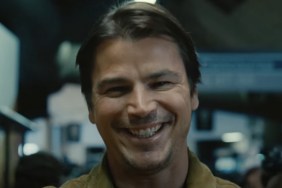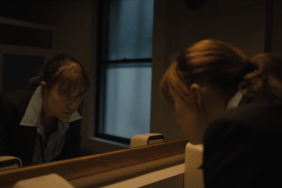First surfacing online in May, the teaser for Blumhouse Productions? The Gallows nearly bucks one of horror?s worst, but least-addressed trends. Clocking in at a lean 75 seconds, the high school-set found footage movie?s initial tease is heavy on atmosphere and light on exposition. There?s just a scared, blonde teenage girl cowering in a room that?s ominously lit in red; as the clip progresses, the camera closes in on her terrified, tear-covered face, harking back to The Blair Witch Project?s infamous ?We?re all gonna die out here!? moment. She nervously cranes her head upward to show the camera the gnarly rope burns and marks that are emblazoned on her neck. Then, there?s a quick glitch. Once the camera is back on her, it?s slowly revealed that there?s now an actual noose placed around the girl?s neck; fear takes over her while intrigue settles in for the viewer. For a second, it starts feeling like The Gallows will have the first legitimately creepy and refreshingly old-school horror trailer in some time?but then the girl gets yanked from behind and dragged down a corridor, while screaming. And the savvy horror fan watching her is left reenacting the Internet?s greatest dog meme.
And just like that, The Gallows falls right in line with the rest of Hollywood?s recent horror movies, which are introduced to the genre community via trailers that think ?scary? equates to ?someone?s violently pulled backwards or sideways by an unseen force.? The eventual full trailer for The Gallows, unveiled online a few weeks later, only makes things worse, adding even cheaper jump scares and a similar to the girl-and-a-noose shot where some dude on a ladder is suddenly flung downwards. The gag looks maddeningly similar to what was shown before the release of this year?s Poltergeist; the remake?s main trailer?s closing money-shot finds this generation?s Carol Ann flying backwards up a staircase.
The repetition doesn?t end there. In the Insidious: Chapter 3 trailer, there?s a closing pre-title-card ?gotcha!? moment where a ghoul hanging outside of window grabs at the camera, checking another one of the modern-day horror trailer?s cliché boxes: the completely telegraphed jump-scare. Which you?ll find in pretty much every horror trailer released in the last few years, indie or big-studio. The previews for Poltergeist and Insidious: Chapter 3 both also adhere to the most obvious convention of them all: Hollywood?s penchant for explaining their movies beat-for-beat in trailers. The characters are laid out, the stakes are fully established and most, if not all, of the film?s scares are seen in a fast-paced montage that?s meant to intrigue but inevitably dilutes the full movie?s impact.
Superior teases like rely on ambiance. A quick revisit session with the genre?s most universally celebrated trailers reveals the common thread that they?re all examples of mood-over-story minimalism. Think about Stanley Kubrick?s iconic set-up for The Shining, which is simply an uninterrupted, slow-motion shot of the Overlook Hotel?s elevators spewing out a river of blood. Or The Exorcist?s ?flash image? trailer, a nearly two-minute-long exercise in seizure-inducing disorientation showing the demon Pazuzu and Ellen Burstyn?s screaming face in black-and-white flashes.
And few will ever forget The Last House on the Left?s infamous trailer, with that classic ?It?s only a movie? disclaimer being chanted on a loop, turning Wes Craven?s debut into more of a potentially dangerous what-the-fuck exercise in malevolence. For a more recent example of a horror trailer done right, give the one for 2008?s excellent home invasion flick The Strangers another look; all you get is the sense that a man and a woman are being terrorized by masked figures in their home, an inherently disturbing proposition made all the more unnerving by a silent scene where Liv Tyler is being watched from behind and then the brilliant cue of Joanna Newsom?s ?The Sprout and the Bean? vocals inaudibly repeating on a skipping vinyl.
None of those trailers rely on rudimentary jump scares, and not a single one of them divulges even a morsel of character back-story, or gets too generous with its world-building. They?re great examples of horror?s old the-less-you-know adage for achieving maximum terror. They?re John Carpenter?s mysterious and restrained version of Michael Myers compared to how most trailers follow the Rob Zombie?s Halloween edict of, ?Tell them everything about Michael Myers.? They were cut by editors and approved by studio heads who trusted horror audiences? collective intelligence. They didn?t spell everything out, or, in other words, dumb everything down. The folks behind those older trailers trusted their product?s quality enough to whisper about it rather than scream into the viewer?s ears.
?Older horror trailers tried to set the mood for what you?re going to be watching,? says Greg MacLennan, the chief trailer editor for Drafthouse Films. ?It was their way of saying, ?This trailer will let you know if this film?s world is a one that you?ll want to inhabit or not, and we?re going to try to place you directly into that world for two minutes here.? Most of today?s stuff, though, is trying to tell you why you should buy a ticket, like, ?Don?t worry, you?re going to get this and that and that and this.??
MacLennan has been cutting Drafthouse Films? trailers since early 2014. He?s the reason why the preview for this year?s horror-romance Spring conceals the film?s monstrous secrets, something that never would?ve happened had co-director Justin Benson and Aaron Moorhead?s film been released by a major studio. ?I got a note from someone outside of our team that said twe needed to show Spring?s horror elements more in order to appeal more to the genre crowd,? recalls MacLennan. ?But the angle I was trying to work more was that this girl has a secret, and the one thing that we can absolutely not tell in the trailer is that secret. I thought it was more important to be faithful to the film?s mood instead of bullshit marketing tactics.?
MacLennan credits negotiations and decisions like that to Spring?s outside-of-the-system existence. Drafthouse Films isn?t 20th Century Fox or Warner Bros., therefore they can handle their releases with personal care. Before giving MacLennan total reign over their pre-release marketing clips, the Drafthouse brass had farmed out their trailers to production houses, removing personality from the equation; with someone in-house, though, they could make sure their trailers were more than just patchwork jobs churned out in assembly-line-like fashion?hence, the lack of monster spoilers in Spring?s trailer.
That kind of one-man attention is less likely to happen with studio releases, unfortunately, due to their reliance on production houses and their multi-member trailer divisions. The exceptions come from auteurs like Christopher Nolan, whose trailers are very clearly Nolan-supervised, since, well, he?s Christopher Nolan. But there are few on Nolan?s level in the big-budget horror space. ?More often than not, filmmakers are forced into specific angles and forced into showing certain things for marketing reasons that end up taking away from what would have made their trailer more special,? says MacLennan. ?Those classic trailers that we all love, like the ones for The Shining, The Thing and The Exorcist, were for movies made by auteurs, and those auteurs had huge says in how their films were marketed. But that doesn?t seem to exist anymore beyond guys like Christopher Nolan.?
The auteurs of yesteryear understood that the best horror suggestions don?t come from cheap thrills, but, rather, something as simple as blood pouring through closed elevator doors. So what brought about the sea change from hint-hint to megaphone-subtle? Blame it partly on the almighty dollar. The numbers don?t lie. The new Poltergeist, for instance, cost an estimated $35 million; that?s a lot of dough for its studio, 20th Century Fox, to gamble its appeal and reach on a trailer that?s anything like that of director Tobe Hooper and producer Steven Spielberg?s 1982 original, which doesn?t show anything supernatural but suggests a great deal of heebie-jeebies through its creepy narration. Since they?re hoping to lure today?s fickle audiences into the theater by any means necessary, Fox?s squad leaves nothing to the imagination in Poltergeist 2015?s trailer, pairing the aforementioned kid-yanked-backwards shots with this version?s answer to Hooper?s clown scare, complete with the damn clown flying towards the screen.
Films like Poltergeist and The Gallows are opening in a time where the majority of movies being made and/or released within the studio system are remakes, sequels, franchise reboots or examples of whatever other kind of established name property rejuvenation Hollywood?s corporations can produce. It?s as much that way for horror as it is for action and sci-fi cinema. The reason for that sad reality is, unsurprisingly, money?why risk losing profits on an original idea when there?s a classic horror flick out there that appears on every ?Best Horror Movies of All Time? list that hasn?t been repurposed yet?
Back when classics like The Exorcist, Rosemary?s Baby, Halloween and The Texas Chain Saw Massacre were first released, that wasn?t predominantly the case. Chances could be taken; originality was paramount. In turn, there was more room to be experimental. Creative minds weren?t as hamstrung by financial pressures as they are now. ?At the time when they were first released, movies like The Thing and The Shining weren?t the tremendous financial risks that studio-released genre movies are today, so they could try different things with the trailers and focus more on targeting the right audience than on trying to get everyone to see their movie,? says MacLennan. ?But when something like the recent Poltergeist remake even costs up to $40 million, there?s less of a security blanket for the studio to try something creative with the trailer.?
There is, however, the comfort of ubiquity. In today?s digital age, studio execs and producers know that their movies? trailers are inescapable. In the past, cinephiles had to visit the local theater to re-watch the latest horror trailers?they didn?t have the Internet nor smartphones with trailer-specific apps. But now, if someone clicks on a YouTube video to watch, say, ?Cat Fails, Volume Two,? they?re instantly greeted by must-watch-first advertisement, and it?s usually a movie trailer. Similarly, if they visit one of their favorite movie blogs, there?s most likely a trailer ready to go once he or she accidentally rolls his or her mouse over the player. Trailers aren?t events anymore?they?re as unavoidable as those bottom-of-the-screen tickers that display the names of random indie rock bands? names and song titles are while you?re watching MTV?s Scream series.
There?s also the fact that movies like The Thing and The Shining are, well, great. It?s possibly easier to get freaky with a movie?s trailer when the movie itself has the goods; an editor or producer can confidently focus on intriguing tension when there?s little doubt that audiences will respond to the whole package once they buy their tickets. They?re able to lure viewers in without expecting them to become an angry mob of money-wasters after they?ve seen the thing. But when there?s nothing that?s any good following a trailer? The people crafting the trailer have little choice but to show the best of what they have, and, more often than not these days, that?s little more than a few jump-scares.
That notion certainly applies to The Gallows, which only has one kinda/sorta scary moment, and it?s when the blonde girl notices the noose?so of course the studio made that the first marketable piece of the movie. Other than that, The Gallows is bargain-bin found-footage nothingness with a douche-bro camera operator and general sense of uneventful familiarity. It?s devoid of any kind of atmosphere one could even partially use to create something like The Shining?s or The Thing?s trailers.
The opposite can be said about It Follows, one of this year?s best horror movies and, fittingly, the benefactor of one of the genre?s best trailers in years. With its vintage, red, A Nightmare on Elm Street-like text, it smartly and assuredly posits that writer-director David Robert Mitchell?s film is worthy of consideration alongside the genre?s best 1980s flicks; giving little information about its characters while succinctly outlining its have-sex-and-be-stalked-by-a-supernatural-force premise. It?s reminiscent of The Strangers? right-to-the-point trailer; and featuring three of the sickest tracks from composer Disasterpeace?s magnificent original score, it drenches audiences in the film?s mood much like The Exorcist?s ?flash image? trailer.
It Follows is a prime example of a high-quality film spawning to an equally high-quality trailer. ?Whenever I?m cutting a trailer, the one thing I always try to keep in my mind is, if I?m riding an elevator with someone, can I give them a one-sentence pitch in order to make him or her want to watch it?? That?s basically the amount of time that you have in a trailer,? says MacLennan. ?The trailer for It Follows does that so damn well. You don?t need to know the characters and their back-stories to make that movie appealing?it?s just, here?s the set-up, and here are the rules. All you want to do after you watch that trailer is ask, ?Okay, but what the fuck happens next, though???
In the end, it always comes back to separating the good from the bad. Instead of waiting for Hollywood to change its way, horror fans should use the industry?s pedestrian ways to fight against it. The next time a new horror trailer hedges its bets on shots of people being thrown across the screen, there?s a strong likelihood that the film will end being The Gallows, not The Shining. Even if it?s as promising as this:
—
Matt Barone is an editor at TribecaFilm.com who?s written for Wired, The Dissolve, Rolling Stone, Complex and Birth.Movies.Death. His Twitter feed is mostly a horror movie soundboard; you can follow him here.










